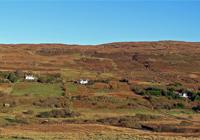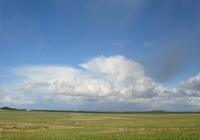Common Grazing in Scotland

Skye, are not covered by laws to
regulate crofters’ common
grazings in Scotland, creating
difficulties for active graziers
© Richard Dorrell
Legal complications and the difficulties of dealing with fellow graziers have always posed greater challenges for common grazing farmers than would be faced by similar sole use hill farms. The introduction of both decoupled CAP area payments and more complicated instruments such as agri-environment has added considerably to these difficulties.
English common land was well documented in 2009 in a report for Natural England, Trends in Pastoral Commoning but there is no work highlighting the state of Scotland’s common grazings or of how they are coping with current policy, let alone how they might be affected by policy changes in the future.
Trends in Common Grazings Report

In 2011 EFNCP produced a major report setting out for the first time a range of statistics about common grazings and attitudes amongst graziers, drawing a range of conclusions for policy.
Some preliminary results were presented in a poster presented at the EFNCP Sibiu conference. Further presentations were given in the IASC conference in Plovdiv and the Crofters Commission Assessors Conference in Inverness in 2011.
The difficulties of moving from historic to regionally-based area payments under the First Pillar are a particular concern. We gave a presentation to the Cross-Party Group on Crofting in the Scottish Parliament, which led to a paper prepared by us being forwarder by the Group to the relevant Minister.
Supporting common grazing through agri-environment

Following on from the Trends report, this major new piece of research analyses detailed data on agri-environment uptake.
It concludes that current provision is inadequate, resulting in much lower uptake by grazings than by other potential applicants.
There are a number of reasons, including:
- Large numbers of grazings which are 'unregulated', i.e. no officially-recognised committee which can be an applicant
- General difficulty of application compounded by additional difficulties for grazings including getting agreement of large numbers of stakeholders and the need to balance needs of inactive and active graziers
- High bureaucratic thresholds, including degree of agreement necessary and requirement to provide accounts
- Weaknesses in advisory provision and lack of capacity in responsible State body to extend regulation and support committees
- Cost of advice/application, especially given transaction costs of grazings
- Paucity of attractive options, and especially of support for positive management, with specific problems with the option to support cattle grazing of rough grazings
Solutions are put forward, including:
- Common grazings must feature specifically and in a quantified way in all sections of the new RDP, from the ex-ante evaluation to measure design and the monitoring plan.
- At least a doubling of advisory provision in marginal areas by building on existing State Aids within the RDP framework. Outcomes should specifically relate not just to small farms but to common grazings and should be accompanied by a review of end-user cost.
- Provision of advice to common grazings on all matters where the scheme does not allow for specific support should be free.
- Appointment of dedicated common grazings advisors, working in collaboration with Government agencies in the overall context of capacity building and community development work on common grazings.
- Improved moorland management measure and replacement of current summer cattle grazing option
- Relaxation of the shareholder consent rules for entry into AE and abolition of the need to provide accounts in support of AE applications
- Provision of support workers for the extension and updating of grazings regulation to the overwhelming majority of grazings, with parallel support for the transaction costs of grazings committees, distinguishing in particular the higher costs of hitherto-unregulated grazings. Synergy with an expanded advisory service would be very desirable indeed. If this measure is deemed inappropriate for funding additional agency staff, the use of technical assistance funding should be considered, as has happened in Wales in the current period.

We also gave a presentation on these issues to the Cross-Party Group on Crofting in the Scottish Parliament; discussions are ongoing as to how the next RDP addresses the specific issues relating to common grazings.
We are working to achieve a better result for land management by crofters in the 2014-20 programming period. As part of this work, we have given two presentations to the Cross-Party Group on crofting in the Scottish Parliament, on Direct Payments and Agri-environment respectively. The former led to the writing of a paper for the Group, which was passed on to the Cabinet Secretary.


